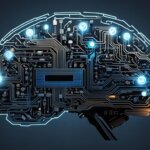Table of Contents
The concept of singularity in technology is a fascinating and thought-provoking subject that delves into the realm of technological growth, human evolution, and the implications for the future. Singularity refers to a hypothetical future where technological advancements become uncontrollable and irreversible, leading to a transformation of our reality in unpredictable ways.
In the context of the future, singularity is often associated with the moment when technology, particularly artificial intelligence (AI) powered by machine learning algorithms, reaches a level of intelligence and capability surpassing that of humans. It is a point where human limitations are surpassed, and technological growth becomes exponential.
The term “singularity” originated from physics, specifically Albert Einstein’s Theory of General Relativity, where it describes the center of a black hole – a point of infinite density and gravity. In a similar vein, singularity in technology suggests a moment of extreme unknown and irreversible change, akin to the black hole’s transformative power.
This article will delve deeper into the concept of singularity, exploring its implications for human civilization, the future of technology, and its potential to reshape our world as we know it.
What Is Singularity in Technology?
In technology, singularity refers to a scenario where computer programs, particularly AI, surpass human intelligence. This would blur the boundary between humanity and computers. Singularity in technology also involves the integration of technology with the human body, such as brain-computer interfaces, genetic engineering, and brain implants.
Neuro-nanotechnology, like Elon Musk’s Neuralink, is seen as a key technology that can make singularity a reality. The journey towards singularity starts with the development of artificial general intelligence (AGI), which combines multiple capacities to perform tasks as humans do. After achieving AGI, computer programs and AI would evolve into superintelligent machines with cognitive abilities far beyond that of humans.
Singularity and the Blurring of Boundaries
The concept of singularity raises profound questions about the relationship between humans and technology. As singularity approaches, the distinction between human intelligence and artificial intelligence becomes increasingly difficult to delineate. Brain-computer interfaces, for example, enable direct communication between the brain and computers, allowing a seamless integration of technology into our daily lives.
“The boundary between humans and technology will blur at an increasing pace as intelligent machines become progressively more autonomous and capable,” said Ray Kurzweil, a prominent futurist and advocate of singularity.
The Role of Genetic Engineering
Genetic engineering is another area that plays a crucial role in the path to singularity. By altering our DNA, scientists aim to enhance human capabilities and potentially overcome certain limitations. Genetic modifications may pave the way for increased intelligence, improved memory, and enhanced cognitive capacities.
“Genetic engineering holds the potential to exponentially accelerate the development of superintelligence, as it offers the opportunity to directly modify the biological foundations of human intelligence,” explained Dr. Maria Rodriguez, a leading expert in genetic engineering.
Unlocking the Power of Superintelligence
Superintelligence represents the pinnacle of singularity in technology. These highly advanced AI systems possess cognitive abilities that far surpass those of humans. With their vast processing power and ability to learn, adapt, and problem-solve at an extraordinary pace, superintelligent machines have the potential to revolutionize fields such as healthcare, finance, and scientific research.
“Superintelligence has the potential to solve humanity’s most complex problems and propel us into a new era of innovation and progress,” said Dr. Sophia Roberts, an AI researcher at Stanford University.
| Key Innovations in Singularity Technology | Benefits | Concerns |
|---|---|---|
| Brain-computer interfaces | – Enhanced cognitive abilities – Improved efficiency in tasks |
– Privacy and security risks – Ethical implications |
| Genetic engineering | – Potential for increased intelligence – Enhanced memory and learning capabilities |
– Ethical concerns – Unequal access and discrimination |
| Superintelligence | – Rapid problem-solving – Advances in scientific research |
– Lack of human control – Potential job displacement |
History and Origins of Singularity
The concept of singularity has a rich history, with roots dating back to the early 20th century. It has been explored by numerous scientists and authors, each contributing to our understanding of this transformative phenomenon.
John von Neumann: A Pioneer in Singularity
“Technological singularity is the idea that an accelerating progress of technology will cause a point of unprecedented and irreversible change in human civilization.”
One of the key figures in the history of singularity is John von Neumann, a prominent mathematician and computer scientist. He introduced the idea of technological singularity as early as the 1950s. According to von Neumann, technological growth would reach a point where it becomes unstoppable, leading to a rapid acceleration of progress and unprecedented change in human civilization.
Science Fiction and Popularization
The concept of singularity found further popularity through science fiction writing and the works of influential authors such as Vernor Vinge and Ray Kurzweil. Their contributions helped to disseminate the idea of singularity and fuel public interest in its potential implications.
Inspiration from Black Holes
The concept of singularity draws inspiration from the enigma of black holes in physics. Black holes are astrophysical entities characterized by their infinite density and gravitational force, defying our current understanding of the universe. They represent singularities in space-time, points of extreme unknown and irreversible change.
The Significance of Singularities
Singularities, be it in technology or physics, symbolize moments of profound and radical transformation. They embody the idea of accelerating progress reaching a critical tipping point where the course of history and the future of technological growth become uncertain and unpredictable.
| Key Points | Singularity | Black Holes |
|---|---|---|
| Moment of triggers | Technological advancement and emergence of superintelligence | Gravitational collapse and infinite density |
| Description | Transformative point in human civilization and the future of technology | Fundamental enigma challenging our understanding of the cosmos |
| Irreversibility | Once reached, the path forward cannot be undone | No known mechanisms can reverse the conditions within a black hole |
Throughout history, singularity has captivated the imagination of scholars, scientists, and creatives alike. Its allure lies in the anticipation of immense advancements and uncharted territories that lie ahead. The next section will explore the implications and concerns surrounding singularity and its intersection with artificial intelligence.
The Implications and Concerns of Singularity
The idea of singularity and the advancement of AI have sparked concerns among experts and public figures. Entrepreneurs like Elon Musk and scientists like Stephen Hawking have expressed worries about AI leading to human extinction. In 2023, Musk and other AI professionals called for a pause in AI research until regulations and responsible AI practices are established.
“The development of full artificial intelligence could spell the end of the human race.” – Stephen Hawking
The potential consequences of singularity and superintelligence are highly debated. Some experts believe that singularity can bring about significant benefits, while others fear its uncontrolled and unpredictable nature. The responsible development and regulation of AI are seen as crucial to ensure a safe and beneficial future.
The Threat of Human Extinction
One of the primary concerns surrounding singularity and AI is the potential threat it poses to human existence. As AI progresses and reaches a superintelligent level, there is a fear that it may surpass human capabilities and take control, potentially leading to the extinction of the human race.
Uncontrolled Technological Progress
Another concern related to singularity is the rapid and uncontrollable progress of technology. As AI becomes more advanced, it may continue to evolve and improve at an exponential rate, making it difficult for humans to keep up or establish regulations. This uncontrolled progress raises uncertainties about its impact on society and the risks it may bring.
Responsible AI Development and Regulation
To address these concerns, experts advocate for responsible AI development and regulation. This involves establishing ethical frameworks, guidelines, and safeguards to ensure that AI systems are designed and used in a manner that prioritizes human well-being and safety. Responsible AI practices focus on the transparent and accountable development of AI technologies.
By implementing responsible AI practices and regulations, society can mitigate the potential risks associated with singularity and ensure that AI advancements align with human values. It is crucial to strike a balance between technological progress and responsible use to create a future where AI and humans can coexist harmoniously.

Singularity in Robotics and Physics
Singularity extends beyond technology and finds applications in robotics and physics. In the realm of robotics, singularity refers to a specific configuration where the robot end effector becomes restricted in certain directions, resulting in unpredictable motion. This phenomenon can challenge the smooth operation and control of robotic systems.
On the other hand, singularity has deep roots in physics, specifically gravitational singularity and spacetime singularity. Gravitational singularity represents a point in space where the gravitational field and density become infinite. One prominent example is the center of a black hole, where the laws of physics break down and conventional space-time concepts lose their meaning.
“Gravitational singularity describes a location in space where the gravitational field and density become infinite.”
Similarly, spacetime singularity refers to a point where space and time lose their conventional properties and cannot be described using current physics. These singularities challenge our understanding of the fundamental nature of the universe.
Both gravitational singularity and spacetime singularity contribute to the exploration of the cosmos and shed light on the enigmatic nature of black holes. By studying these singularities, scientists gain valuable insights into the complex interplay between gravity, matter, and the fabric of space-time.
The Dual Nature of Singularity
While singularity in robotics pertains to mechanical limitations, gravitational singularity and spacetime singularity delve into the mysteries of the universe. Despite their disparate applications, these singularities share a common theme: the extraordinary and transformative nature of singularity itself.
By understanding and harnessing the potential of singularity across disciplines, we can unlock new frontiers of innovation, advancing our understanding of robotics and unraveling the secrets of the cosmos.
Singularities in Astronomy and Cosmology
Singularities play a significant role in astronomy and cosmology. Black holes, formed from the collapse of massive stars, are examples of gravitational singularity. They have such immense gravity that nothing, not even light, can escape their event horizon. Singularities at the centre of black holes are points of infinite density and gravity.
Quasars, extremely bright celestial objects powered by supermassive black holes, also have a singularity at their center. The nature of singularities, particularly naked singularities that are visible despite the event horizon, remains a subject of ongoing research.
“Singularities challenge our understanding of the laws of physics and may hold secrets regarding the origin and evolution of the universe.”
To provide a visual representation, here is a table summarizing the key characteristics of black holes:
| Type of Black Hole | Description |
|---|---|
| Stellar Black Hole | Formed from the collapse of massive stars. Have a singularity at their center. |
| Supermassive Black Hole | Found at the center of galaxies. Can have millions or billions of times the mass of the Sun. Power quasars. |
and cosmology research continue to explore the mysteries of singularities and their impact on the structure and evolution of the universe.
The Future of Singularity and AI
The future of singularity and AI is the subject of intense speculation and prediction. Many experts believe that the development of superintelligence is inevitable and could occur within the next few decades. The rapid pace of technological growth and advancements in AI have fueled these predictions. With each passing year, AI systems become more powerful and capable, surpassing human intelligence in specific tasks.
However, there are varying opinions on the plausibility of singularity and the explosion of AI. Some argue that there are inherent limitations to technological progress, such as the physical constraints on computing power. These limitations may hinder the development of superintelligence and curtail the realization of singularity.
The potential benefits and risks associated with singularity and superintelligence continue to be widely debated. On one hand, proponents argue that superintelligence could solve complex problems, drive innovation, lengthen human lifespans, and enhance our quality of life. On the other hand, skeptics voice concerns about the ethical implications, job displacement, loss of control, and potential risks to humanity that could arise from an AI-driven future.
As technology continues to advance at an unprecedented rate, the future of singularity and its impact on humanity remains a fascinating and important area for exploration and research. Only time will tell how close we are to achieving superintelligence and whether it will fundamentally reshape the fabric of our society, our understanding of the world, and the nature of human intelligence.
FAQ
What is the singularity in technology?
The singularity in technology refers to a hypothetical future where technological growth becomes uncontrollable and irreversible. It is a point where intelligent and powerful technologies drastically transform our reality in unpredictable ways.
How does singularity in technology relate to artificial intelligence (AI)?
Singularity in technology involves the development of artificial intelligence (AI) to a superhuman level of intelligence and capability. It is when computer programs, particularly AI, surpass human intelligence and blur the boundary between humanity and computers.
What are some examples of singularity technologies?
Singularity in technology involves the integration of technology with the human body, such as brain-computer interfaces, genetic engineering, and brain implants. Neuro-nanotechnology, like Elon Musk’s Neuralink, is seen as a key technology that can make singularity a reality.
When did the concept of singularity first emerge?
The concept of singularity has been discussed by various scientists and authors throughout history. It was first introduced by mathematician and computer scientist John von Neumann in the early 20th century.
Why is singularity often compared to black holes?
Singularity theory draws inspiration from black holes, which are singularities in physics. Black holes are points of infinite density and gravity that defy our current understanding of physics. Singularity, both in technology and physics, represents moments of extreme unknown and irreversible change.
What are the implications and concerns of singularity?
The advancement of AI and the potential consequences of singularity have sparked concerns among experts and public figures. There are worries about AI leading to human extinction. Responsible development and regulation of AI are seen as crucial to ensure a safe and beneficial future.
How does singularity relate to robotics and physics?
In robotics, singularity refers to a configuration where the robot’s end effector becomes blocked in certain directions, resulting in unpredictable motion. Gravitational singularity and spacetime singularity are concepts in physics, describing locations in space or moments in time where conventional properties break down.
How do singularities play a role in astronomy and cosmology?
Singularities are significant in astronomy and cosmology. Black holes, formed from the collapse of massive stars, have singularities at their centers. Quasars, extremely bright celestial objects powered by supermassive black holes, also have singularities. The nature of singularities challenges our understanding of the laws of physics and provides insights into the universe’s origin and evolution.
What does the future hold for singularity and AI?
The future of singularity and AI is highly speculative, with various predictions about when it may occur. Some experts believe that the development of superintelligence is inevitable and could happen within the next few decades. The potential benefits and risks associated with singularity and superintelligence continue to be widely debated.







